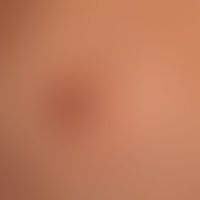Image diagnoses for "Hardening (cutis, subcutis - nodular/plate-like)"
55 results with 128 images

Dermatoliposclerosis I83.1
Dermatoliposclerosis. 64-year-old female patient with known CVI. For years increasing hardening of the distal and middle third of the US (so-called bottle bone). Extensive hyper - and depigmentation of the skin with wood-like, coarse increase in consistency.

Scleroderma and coup de sabre L94.1
Scleroderma en coup de sabre: hairless porcelain-like plaque that has been growing for years.
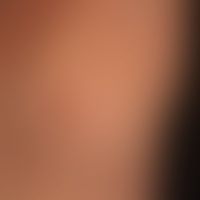
Mondor's disease I82.1
Mondor's disease: suddenly appeared, strand-like, about 7 cm long, firm, only slightly pain-sensitive induration; no underlying disease known.
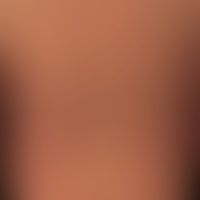
Scleromyxoedema L98.5
Scleromyxoedema: Multiple, symmetrically distributed, 0.1-0.2 cm large, roundish, non follicular papules with smooth, shiny surface.
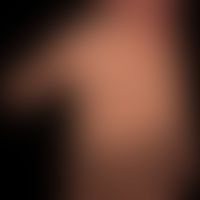
Scleromyxoedema L98.5
Scleromyxoedema: waxy, flat hardened palms; changes can be detected mainly on the fingers and over the finger base joints.
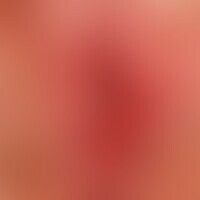
Vulvar lichen sclerosus N90.4
Long-standing lichen sclerosus of the vulva with complicated carcinoma development (see following figure); complete atrophy of the small labia.
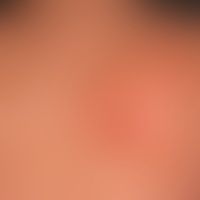
Radiodermatitis chronic L58.1
Chronic radiodermatitis: Condition following radiation of a bronchial carcinoma.

Lipodermatosclerosis L94.0
Hypodermitis: extensive reddening and induration of the lower leg. Painful if finger pressure is applied firmly. The tissue can be dented by prolonged finger pressure.

Papillomatosis cutis lymphostatica I89.0
Papillomatosis cutis lymphostatica:large-area, distally sharply defined, proximally tapering, coarsely indurated, large-area, verrucous plaque with smaller nodules; condition following recurrent erysipelas.

Graft-versus-host disease chronic L99.2-
Graft-versus-Host Disease: extensive scleroderma indurations of the arms and legs.
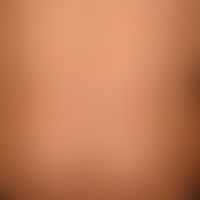
Graft-versus-host disease chronic L99.2-
Generalized GVHD: chronic, generalized, poikilodermatic skin changes, with circumscribed calluses, atrophy and reticular hyperpigmentation.

Lichen sclerosus (overview) L90.4
Lichen sclerosus et atrophicus: massive infestation of the vulva with bulging sclerosing of the labia majora and labia minora, first changes had occurred 10 years ago.
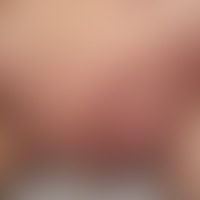
Suppurative hidradenitis L73.2
Hidradenitis suppurativa, a widespread and progressive condition with papules, pustules, nodules, indurated, ductal fistulae and consecutive chronic lymphedema.
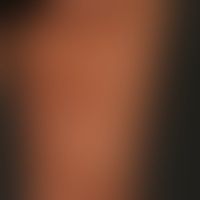
Scleroderma linear L94.1
Scleroderma ligamentous: for years slowly progressive, only moderately indurated ligamentous morphea in a 42-year-old woman; no movement restrictions of the joints.

Scleroderma linear L94.1
Scleroderma ligamentous: for years slowly progressive, only moderately indurated ligamentous morphea in a 42-year-old woman; no movement restrictions of the joints.

Graft-versus-host disease L99.1/L99.2
Graft-versus-Host-Disease. 12 months after transplantation, reaction due to transmission of allogenic immunocompetent T-lymphocytes. extensive dermatosclerosis with numerous, bizarre, skin-coloured papules and plaques.
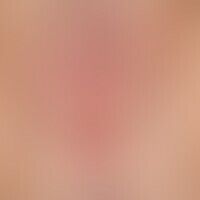
Vulvar lichen sclerosus N90.4
Lichen sclerosus of the vulva: verrucous lichen sclerosus with synecchia between small and large labia, extensive atrophy of the small labia with narrowing of the introitus vaginae.
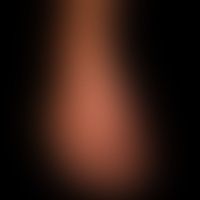
Poems syndrome C90.2
POEMS syndrome: flat, even hyperpigmentation with "scleroderma-like" hardening and swelling of the forearm and back of the hand.
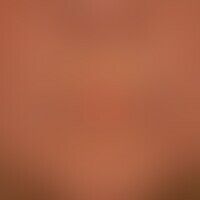
Scleroderma systemic M34.0
Scleroderma, systemic: taut, shiny facial skin (see chin region); distinct perioral fibrosis, which becomes clearly visible when the lips are tapered.
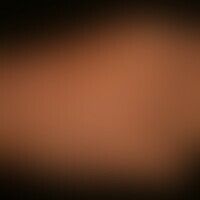
Scleroderma systemic M34.0
Scleroderma, systemic (sclerosis of the hands): Raynaud's syndrome, known since puberty, palmar hyperhidrosis, slight doughy swellings with reduced skin shifting; sclerosis becomes apparent when the fingers are simply bent.

Varicosis (overview) I83.9
Bilateral varicosis: trunk varicosis of the V. saphena magna; pronounced CVI of both lower legs.

Chronic venous insufficiency (overview) I87.2
Venous insufficiency chronic: pronounced congestive dermatitis with extensive induration of both lower legs.

Lichen sclerosus (overview) L90.4
Laser scanning microscopy: Subepithelial, band-shaped homogeneous swelling zone of collagenous connective tissue, isolated inflammatory cells
